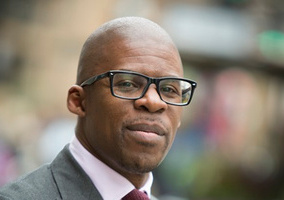This blog is about race. Specifically, it’s about one statistic. It’s about the fact that charities have fewer staff from BAME backgrounds than either the public or private sectors.
The recent UK Civil Society Almanac contains work by Marc Lawson, a data scientist at NCVO, which shows that only 9 per cent of the sector is non-white, compared to 12 per cent of the private sector and 11 per cent of the public sector.
Those statistics aren’t good enough. I think everyone believes the charity sector should be an over-employer of people from disadvantaged backgrounds, and if the evidence suggests it isn’t, we have to ask why.
I'm always slightly uncomfortable writing about issues of diversity, because I'm a straight white man from a well-off background. But I think Thomas Lawson, chief executive of Leap Confronting Conflict, eloquently made the point that white men make up a lot of the decision-makers in the sector, and have to talk about race.
It would be easy to assume that the lack of BAME people in the sector is down to simple prejudice. But this seems unlikely. I don’t think anyone is seriously suggesting the sector is less tolerant in its attitudes than the country as a whole.
On some measures of equality, the sector appears to be performing well. On gender pay, for example, the headline gap is low. Among almost 400 bodies which meet NCVO's general charities definition, which between them employ half the charity workforce, the median pay gap is under 2 per cent.
What are we comparing charities with?
First, it’s worth wondering what the right metric is. The UK as a whole is around 87 per cent white, but these figures vary with age and location. Younger people, and people living in London, are much more likely to be from a BAME group.
It's also worth thinking about what exactly we're comparing charities to. When we think of the private sector, some people tend instinctively to think of the management level, but it includes restaurants and factories and farming and scores of other industries, some of which may employ a disproportionate number of non-white individuals. Similarly the public sector includes the armed forces and the NHS, both of which employ people from a broad range of backgrounds. It is fairly shameful that there are certain professions which are more acceptable and more welcoming to people of certain skin colours, but it appears to be very strongly the case.
It's also worth considering that BAME is a catch-all term and we tend to assume that it’s synonymous with disadvantage. On average, people from BAME backgrounds do earn less, but some groups – notably people of Indian and Chinese heritage – may actually perform better on average than white people in terms of average salary. Figures from the ONS show median incomes for these ethnic groups to be £700 to £800 per week, compared to £500 to £600 for white British people.
This prompts me to wonder which BAME groups are most common in the sector, but it appears that the figures available at present are not statistically reliable.
It’s perhaps also worth saying that the sector is probably more exclusionary than it looks. A significant proportion of the sector’s BAME population could well be clustered in charities that are only open to people of one religion and ethnic group. It’s hard to identify exactly how many, although most ethnicities have a significant number of charities attached. There are 290 Somali charities, for example, and 121 Polish ones.
What are the factors affecting recruitment?
The sector’s poor performance on diversity may be partly down to extrinsic factors. A significant proportion of the sector's workforce is made up of people on relatively low wages delivering social care, for instance. If for whatever reason the social care profession is not welcoming to diverse backgrounds, this will drive down the proportion of BAME individuals.
A very significant amount of the rest of the sector workforce is drawn from degree-educated individuals, predominantly those who studied social sciences and arts subjects, and this too is a major barrier to entry. Publicly available evidence of academic achievement by race is a bit sparse, but I suspect less people of BAME backgrounds graduate in those subjects, particularly with good degrees from Russell Group universities. So if the sector recruits proportionately, charities will end up with an unrepresentatively white workforce.
And that’s assuming charities are recruiting proportionately, which seems unlikely. We know that people with names that don’t sound British are less likely to be invited for interviews, right across the UK. It seems very unlikely that charities are immune to this prejudice. We know it’s made worse because particular minority groups become convinced that their face won’t fit, and stop even applying. I suspect this may have happened in the charity sector. I suspect big charities, in particular, are perceived by some as a club for posh white liberals who read sociology at Durham.
What can we do about it?
So those are some of the factors leading to poor representation from BAME groups in charity. Now, what is to be done?
I am not a recruitment expert, so my answers are not comprehensive, but I suspect many of us know the best practice and just aren’t bothering to apply it when we recruit.
One obvious answer is to stop gold-plating your entry requirements. Does the job you’re advertising really need a degree? Do you need them to do an internship that only middle-class people will apply for?
Then there are various best practice tools to ensure that you’re not tricking yourself into hiring someone who looks just like you. Review CVs without names. Explicitly state that people of all backgrounds are welcome, to make everyone feel empowered to apply. Make sure that interview panels are not all white and all male. Use a points-based system to make a decision so that you are more objective. And if you can’t decide between two candidates, pick the black woman over the white man.
The sector also has another tool up its sleeve: start from the top. Ensure that trustee boards are inclusive and representative wherever possible. It’s a sad fact that a charity trustee is up to 400 times as likely to be a retired white man who was tapped up by a pal, compared to a working black woman who was recruited through an open process.
One final word. This article is about race, but the problem is likely the same on other indicators of social mobility. A recent piece by Diane Lightfoot of the Business Disability Forum said that while charities talk a good game on disability they are less likely to make the hire. I suspect the same is true when it comes to social background. I suspect people working in the charity sector – particularly in large, London-based charities – are more likely to be the children of wealthy, well-educated individuals than is the case in society as a whole.
It’s time for this to change.
|
Related articles











